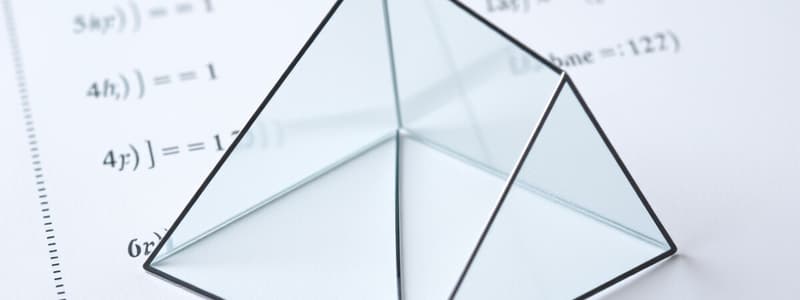Podcast
Questions and Answers
What is the correct definition of an expression in algebra?
What is the correct definition of an expression in algebra?
- A symbol representing a number.
- A statement that two expressions are equal.
- A value that makes an equation true.
- A combination of variables and constants. (correct)
What is the area formula for a triangle?
What is the area formula for a triangle?
- A = base * height
- A = 1/2 * base * height (correct)
- A = 1/3 * base * height
- A = πr^2
What represents a linear function?
What represents a linear function?
- f(x) = x^2 + 3
- f(x) = ab^x
- f(x) = x^3
- f(x) = mx + b (correct)
In statistics, what does the mode represent?
In statistics, what does the mode represent?
What is the correct application of the Pythagorean theorem?
What is the correct application of the Pythagorean theorem?
Which statement about qualitative data is true?
Which statement about qualitative data is true?
What does the cosine ratio represent in trigonometry?
What does the cosine ratio represent in trigonometry?
How is the probability of an event calculated?
How is the probability of an event calculated?
Flashcards are hidden until you start studying
Study Notes
Algebra
-
Definitions:
- Variables: Symbols representing numbers (e.g., x, y).
- Expressions: Combinations of variables and constants (e.g., 3x + 2).
- Equations: Statements that two expressions are equal (e.g., 2x + 3 = 7).
-
Key Concepts:
- Solving Equations: Finding the value of variables that makes the equation true.
- Factoring: Breaking down expressions into products of simpler factors.
- Functions: Relationships where each input has a single output (e.g., f(x) = x^2).
-
Types of Functions:
- Linear: f(x) = mx + b (straight line).
- Quadratic: f(x) = ax^2 + bx + c (parabola).
- Exponential: f(x) = ab^x (growth/decay).
Geometry
-
Basic Shapes:
- Points: No dimensions, defined by coordinates.
- Lines: Straight, one-dimensional, extending infinitely in both directions.
- Angles: Formed by two rays, measured in degrees.
-
Key Properties:
- Triangles: Sum of angles = 180°. Types include equilateral, isosceles, and scalene.
- Circles: Defined by radius (distance from center) and diameter (twice the radius).
- Polygons: Closed figures with straight sides; classified by number of sides (e.g., pentagon, hexagon).
-
Formulas:
- Area of triangle: A = 1/2 * base * height.
- Area of circle: A = πr^2.
- Pythagorean theorem: a² + b² = c² (in right triangles).
Statistics
-
Data Types:
- Qualitative: Categorical data (e.g., colors, names).
- Quantitative: Numerical data (e.g., heights, weights).
-
Descriptive Statistics:
- Mean: Average of data set.
- Median: Middle value when data is ordered.
- Mode: Most frequently occurring value.
-
Probability:
- Definition: Measure of the likelihood of an event occurring.
- Basic Formula: P(A) = Number of favorable outcomes / Total number of outcomes.
Trigonometry
-
Basic Functions:
- Sine (sin): Opposite side / Hypotenuse.
- Cosine (cos): Adjacent side / Hypotenuse.
- Tangent (tan): Opposite side / Adjacent side.
-
Key Ratios:
- sin(θ) = Opposite / Hypotenuse.
- cos(θ) = Adjacent / Hypotenuse.
- tan(θ) = Opposite / Adjacent.
-
Important Identities:
- Pythagorean identity: sin²(θ) + cos²(θ) = 1.
- Angle addition formulas:
- sin(A + B) = sinA * cosB + cosA * sinB.
- cos(A + B) = cosA * cosB - sinA * sinB.
-
Unit Circle:
- Circle with radius 1 centered at the origin; aids in defining trigonometric functions for all angles.
Algebra
- Variables are symbols (e.g., x, y) that represent numbers in mathematical expressions and equations.
- Expressions consist of variables and constants combined (e.g., 3x + 2).
- Equations assert that two expressions are equal (e.g., 2x + 3 = 7).
- Solving Equations involves determining the variable values that satisfy the equation’s conditions.
- Factoring transforms expressions into products of simpler factors for easier manipulation.
- Functions describe relationships where each input corresponds to a single output (e.g., f(x) = x²).
- Function Types:
- Linear functions take the form f(x) = mx + b and graph as straight lines.
- Quadratic functions are expressed as f(x) = ax² + bx + c, creating parabolic shapes.
- Exponential functions are represented by f(x) = ab^x, modeling growth or decay.
Geometry
- Basic Shapes include points (no dimensions), lines (infinite extension), and angles (formed by two rays).
- Triangles have angle sums totaling 180°, with categories like equilateral (equal sides), isosceles (two equal sides), and scalene (all sides different).
- Circles are defined by the distance from the center (radius) and the diameter, which is twice the radius.
- Polygons are closed figures with straight sides, categorized by the number of sides (e.g., pentagons and hexagons).
- Area Formulas:
- For triangles, A = 1/2 * base * height.
- For circles, A = πr², where r is the radius.
- The Pythagorean Theorem states in right triangles, a² + b² = c², relating the sides of the triangle.
Statistics
- Data Types include:
- Qualitative data, which is categorical (e.g., colors, names).
- Quantitative data, which involves numerical measurements (e.g., heights, weights).
- Descriptive Statistics metrics:
- Mean is the average of a data set.
- Median is the middle value in an ordered data set.
- Mode is the most frequently occurring value in a data set.
- Probability measures the likelihood of an event’s occurrence.
- The basic probability formula is P(A) = Number of favorable outcomes / Total number of outcomes.
Trigonometry
- Basic Functions involve ratios based on right triangles:
- Sine (sin) is calculated as Opposite side / Hypotenuse.
- Cosine (cos) is calculated as Adjacent side / Hypotenuse.
- Tangent (tan) is calculated as Opposite side / Adjacent side.
- Key Ratios for angles:
- sin(θ) = Opposite / Hypotenuse.
- cos(θ) = Adjacent / Hypotenuse.
- tan(θ) = Opposite / Adjacent.
- Important Identities:
- The Pythagorean identity states that sin²(θ) + cos²(θ) = 1.
- Angle addition formulas help calculate sine and cosine for combined angles:
- sin(A + B) = sinA * cosB + cosA * sinB.
- cos(A + B) = cosA * cosB - sinA * sinB.
- The Unit Circle is a circle with a radius of 1 centered at the origin, providing a foundation for defining trigonometric functions across all angles.
Studying That Suits You
Use AI to generate personalized quizzes and flashcards to suit your learning preferences.




